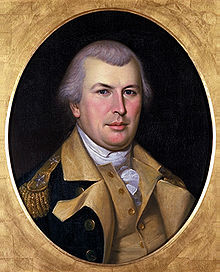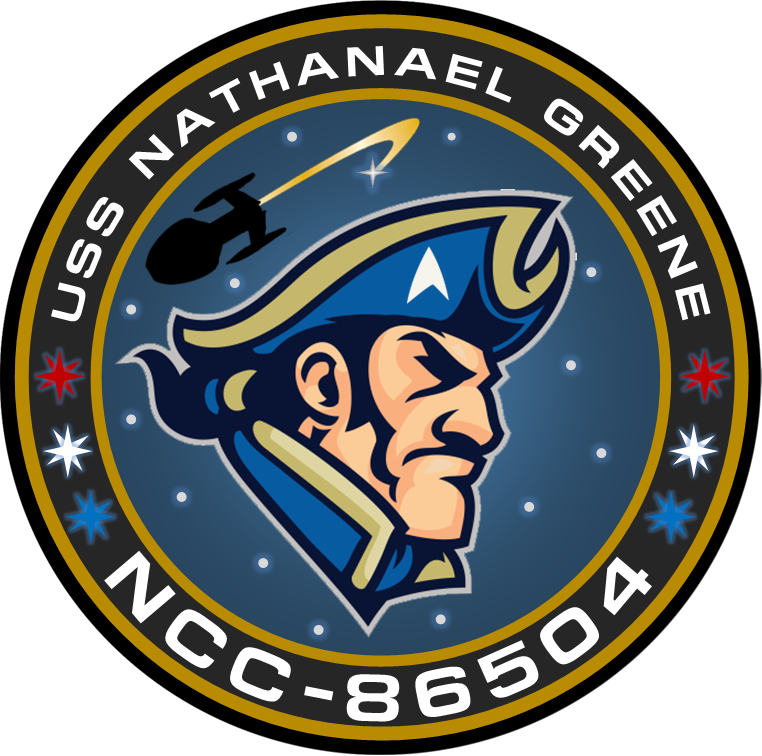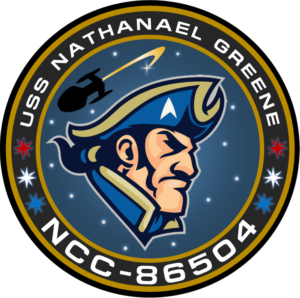
The USS Nathanael Greene NCC-86504 began its journey as a correspondence independent Star Trek fan club. The crew started out as just a friendly group of online friends who shared Star Trek and Science Fiction in common. A member of our group expressed in interest in forming a more formal group and set a goal of becoming a chapter of STARFLEET TASK FORCE 31.
On June 1, 2022 we formally named our group the USS Nathanael Greene, named after the famous American Revolution hero from the State of Rhode Island, General Nathanael Greene.
On July 1, 2022 we were officially launched as the Shuttle Nathanael Greene NX-86504. Our support chapter was the USS Helen Pawlowski.
We started out on our five-month shakedown cruise, we created our membership materials, a chapter handbook, and organized into working departments. Also, during this time, we participated in joint events such as our MACO Company competed against other MACO Companies in an online game of Call of Duty: WWII on a monthly basis. Also, during this time, we participated in the Task Force 31 recycling program.
After the completion of our five-month shakedown cruise, we were officially commissioned as the USS Nathanael Greene NCC-86504 on December 1, 2022 and begin patrolling our area of responsibility.
The Future?


Nathanael Greene was born on August 7, 1742, in Potowomut, Rhode Island, to his Father of the same name, and his mother, Mary Mott. While his family was practicing Quakers, discouragers of extensive learning, the young Nathanael spent every cent available to him on books, amassing a substantial library in the process. A local minister named Ezra Stiles, a man who would become the President of Yale University, guided much of Nathanael’s early learning.
In 1770, Greene’s father purchased a forge in Coventry, Rhode Island, which Nathanael was placed in charge of. While in Coventry, he had a sizable influence in the creation of the first school in the town, and was elected to the general assembly from there. Nathanael also began to gain an interest in military doctrine, adding many books on the subject to his repertoire of written works. His interest in said doctrines was so intense that he was called before a Quaker committee for examination on the grounds that he was not embracing the pacifistic nature of the religion. When the committee was unable to turn Nathanael from his interest, the case was dropped.
Greene married Catharine Littlefield in July 1774. They had 5 children.
August of the same year saw Green involved with the organization of a Rhode Island militia unit, chartered under the name “Kentish Guards”. Due to this, and his increased vigor on the study of military matters, Greene was expelled from the Quaker religion.
Despite him being a founding member of the Guards, he was disallowed from advancing beyond the rank of private within their ranks because of a slight limp, which had troubled him since his birth. Greene was, however, an incredibly important member of the militia, convincing a British Drill Sergeant to desert his unit to train the militia. Greene was also instrumental in acquiring an instructor for a fife and drum corps.
After the events of Lexington and concord, Rhode Island fielded three regiments to aid the Patriots in Boston. The General Assembly considered three individuals for the command of the regiments. Nathanael Green was selected, and promoted from Private to Brigadier General. The level of organization within Greene’s regiments impressed the newly appointed commander of Continental forces, General George Washington. Greene would become Washington’s most trusted advisor and good friend.
In August of 1776 Greene was promoted to Major General, and was tasked with defending Long Island. The site of his greatest military catastrophe took place in nearby Manhattan, where his refusal to retreat from Fort Washington caused several cannons and a few thousand Continental soldiers to be captured by British forces. This was not the end of Greene’s military career however; he and his unit went on to serve with distinction by defending the left flank of US forces at Trenton, enforcing weak points in the battle lines at Brandywine, actions which almost certainly prevented Washington’s forces from complete destruction, and acting as the rear guard in Germantown.
The Continental army’s supply lines and resources were being poorly mismanaged at Valley Forge in 1778. General Washington placed his trust in the abilities of Nathanael Greene to effectively correct the discrepancies with supplies, and Greene was appointed Quartermaster General in March of that same year and held the position until summer of 1780. At one point, during Washington’s absence to meet with French forces, Greene was the commander of the entire continental army, and successfully defeated British forces in parts of New Jersey during this time. He went on to take command of West Point until the arrival of Washington.
General Greene was selected as the Commander of the Southern Continental Army on October 14, 1780. As General Gates replacement, Greene inherited an incredibly small and disorganized army. However, being a masterful military tactician, he successfully employed his small forces in woodland hit and run warfare, decimating Redcoat supply routes and communication abilities. The British forces in the Southern colonies were forced to retreat to their bastion port cities. As a last effort to expel Greene’s forces from the state of South Carolina, British General Cornwallis ordered a subordinate General Clinton to push Greene’s army to the North. Eventually, General Greene chose the grounds of Gilford Courthouse, North Carolina, to cease his feigned retreat and assault the pursuing British forces. Here Nathanael Greene exhibited the full measure of his military brilliance by establishing three phases to the battle. First, Greene ordered the newly recruited militiamen of North Carolina to the front lines where they would take position behind a long wooden fence upon which they could lay their muskets and have increased accuracy. In front of them lay a tilled field which would inhibit the speed of the British advance. When the Redcoats were nearly upon them, they fell back into heavy woodlands where the tight formations of the English forces would be difficult to maintain. Waiting in the forest were members of the battle-hardened Virginia militia. These men engaged the Redcoats in close quarters combat with blades, bayonets, and tomahawks, before falling back and sniping the British from behind tree cover. The militia fell back to join the main force of the Continental Army, whom the Englishmen would face after exiting the woods, crossing a creek, and marching up the hill upon which the Patriots were stationed. Fighting was swaying so badly against the British that, under orders from General Cornwallis, the English cannons fired into masses of men comprised of both Colonists and Redcoats. Greene and his forces eventually withdrew in order to preserve their fighting strength. The forces loyal to the crown of England, however, were badly bloodied.
Greene then surged back into South Carolina, sweeping any English forces he found back to the coast. The war ended soon after his victories, and Greene turned towards civilian pursuits. He oversaw the placement of elected governments in the states of Georgia and South Carolina before finally retiring to a plantation named Mulberry Grove, which was gifted to him by Georgia for his services in the revolution and afterwards, in 1785. Two years later, Nathanael Greene passed away due to sunstroke, leaving behind his two sons, three daughters, and his wife. He was 44 years old.

 |  |  |
| Logo 2022 | Founding Region | Current Support Chapter |
Previous Chapter Commanding Officers
| Captain Thomas Greene | ||
| 202207.01 – Present |



